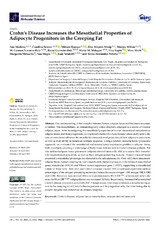Crohn’s Disease Increases the Mesothelial Properties of Adipocyte Progenitors in the Creeping Fat
Autor
Madeira, Ana
Serena, Carolina
Ejarque, Miriam
Maymó-Masip, Elsa
Millán, Mónica
Navarro-Ruiz, Carmen
Guzmán Ruiz, R.
Malagón, María M.
Espin, Eloy
Martí, Marc
Menacho, Margarita
Megía, Ana
Vendrell, Joan
Fernández-Veledo, Sonia
Editor
MDPIFecha
2021Materia
Crohn’s diseaseAdipose tissue
Mesothelium
Adipose-derived stem cells
METS:
Mostrar el registro METSPREMIS:
Mostrar el registro PREMISMetadatos
Mostrar el registro completo del ítemResumen
Our understanding of the interplay between human adipose tissue and the immune system is limited. The mesothelium, an immunologically active structure, emerged as a source of visceral adipose tissue. After investigating the mesothelial properties of human visceral and subcutaneous adipose tissue and their progenitors, we explored whether the dysfunctional obese and Crohn’s disease environments influence the mesothelial/mesenchymal properties of their adipocyte precursors, as well as their ability to mount an immune response. Using a tandem transcriptomic/proteomic approach, we evaluated the mesothelial and mesenchymal expression profiles in adipose tissue, both in subjects covering a wide range of body-mass indexes and in Crohn’s disease patients. We also isolated adipose tissue precursors (adipose-derived stem cells, ASCs) to assess their mesothelial/mesenchymal properties, as well as their antigen-presenting features. Human visceral tissue presented a mesothelial phenotype not detected in the subcutaneous fat. Only ASCs from mesenteric adipose tissue, named creeping fat, had a significantly higher expression of the hallmark mesothelial genes mesothelin (MSLN) and Wilms’ tumor suppressor gene 1 (WT1), supporting a mesothelial nature of these cells. Both lean and Crohn’s disease visceral ASCs expressed equivalent surface percentages of the antigen-presenting molecules human leucocyte antigen—DR isotype (HLA-DR) and CD86. However, lean-derived ASCs were predominantly HLA-DR dim, whereas in Crohn’s disease, the HLA-DR bright subpopulation was increased 3.2-fold. Importantly, the mesothelial-enriched Crohn’s disease precursors activated CD4+ T-lymphocytes. Our study evidences a mesothelial signature in the creeping fat of Crohn’s disease patients and its progenitor cells, the latter being able to present antigens and orchestrate an immune response.

